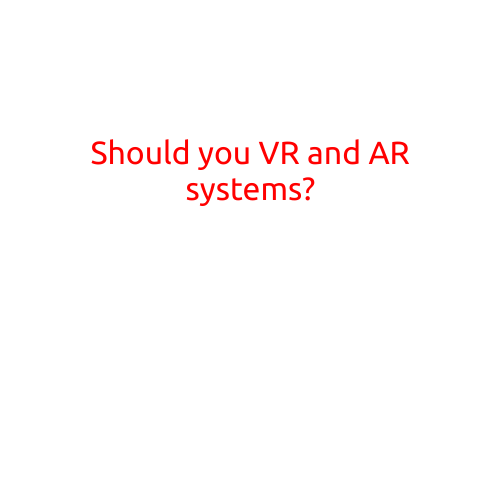
Should You Invest in VR and AR Systems?
Virtual Reality (VR) and Augmented Reality (AR) technologies have been gaining popularity in recent years, with applications in various industries such as gaming, education, healthcare, and entertainment. As the technology continues to evolve, many businesses and individuals are wondering whether they should invest in VR and AR systems. In this article, we’ll explore the benefits and drawbacks of VR and AR systems to help you make an informed decision.
What are VR and AR Systems?
Before we dive into the pros and cons, let’s define what VR and AR systems are:
- Virtual Reality (VR): A VR system creates a completely immersive experience, transporting users to a simulated environment that is separate from the physical world. VR technology uses a headset, sensors, and controllers to track the user’s movements, providing a seamless and interactive experience.
- Augmented Reality (AR): An AR system, on the other hand, enhances the physical world by overlaying virtual information, objects, or interactive elements onto it. AR technology uses a device’s camera to superimpose digital information onto real-world objects, providing a more interactive and engaging experience.
Benefits of VR and AR Systems
- Increased Immersion and Engagement: VR and AR systems offer a new level of immersion and engagement, allowing users to interact with digital content in a more immersive and realistic way.
- Cost Savings: VR and AR systems can reduce costs in various industries, such as healthcare, training, and education, by minimizing the need for physical prototypes, travel, and equipment.
- Enhanced Training and Simulation: VR and AR systems are ideal for training and simulation purposes, allowing users to practice and refine skills in a safe and controlled environment.
- Improved Product Design and Prototyping: VR and AR systems enable designers and engineers to create and prototype new products, reducing the need for physical prototypes and streamlining the design process.
- New Revenue Streams: VR and AR systems open up new revenue streams through the development of immersive gaming experiences, interactive advertising, and virtual events.
Drawbacks of VR and AR Systems
- Cost: While VR and AR systems can reduce costs in some areas, the initial investment in hardware and software can be significant.
- Hardware and Software Requirements: VR and AR systems require specific hardware and software configurations, which can be a barrier for some users.
- Limited Content: The availability of high-quality VR and AR content is still limited, which can be a major drawback for some users.
- User Experience: VR and AR systems can be prone to technical issues, such as motion sickness and eye strain, which can negatively impact the user experience.
- Data Security: VR and AR systems can pose security risks, particularly in healthcare and finance, as they require the collection and storage of personal data.
Conclusion
Investing in VR and AR systems can be a game-changer for many businesses and individuals. While there are some drawbacks, the benefits of increased immersion, engagement, and cost savings make them an attractive option. By carefully considering the pros and cons, you can determine whether VR and AR systems are right for your needs.
Who Should Consider Investing in VR and AR Systems?
- Gaming and Esports Enthusiasts: If you’re an avid gamer or esports fan, VR and AR systems can provide a new level of immersion and engagement.
- Businesses and Entrepreneurs: Companies looking to reduce costs, improve product design and prototyping, and enhance training and simulation can benefit from VR and AR systems.
- Educators and Trainers: Educators and trainers seeking to enhance the learning experience and provide interactive training experiences can benefit from VR and AR systems.
- Healthcare Professionals: Healthcare professionals can use VR and AR systems for therapy, patient education, and training purposes.
Final Thoughts
VR and AR systems are transforming the way we interact with digital content and physical environments. While there are some drawbacks, the benefits of increased immersion, engagement, and cost savings make them an attractive option for many businesses and individuals. By carefully considering the pros and cons, you can determine whether VR and AR systems are right for your needs.





